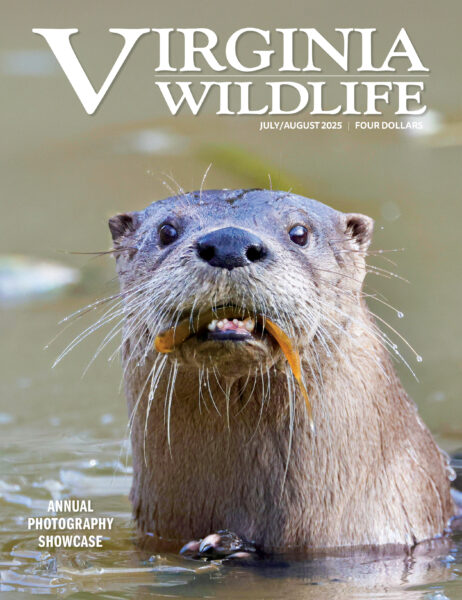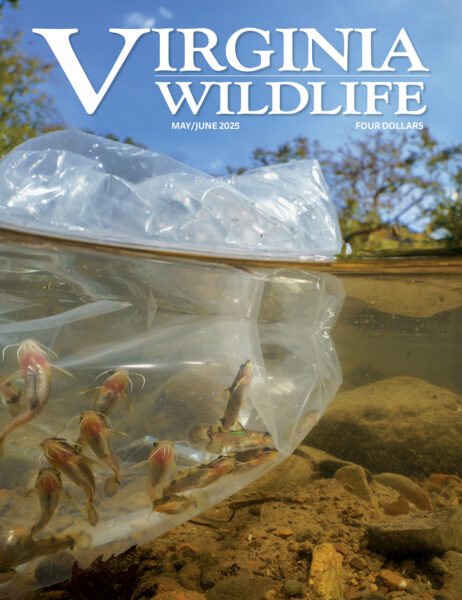These bright, unique fish are often overlooked in Virginia’s waters, but they’re fun to find.
By By Michael J. Pinder/DWR
When you think of flashy, colorful fish, tropical coral reefs might come to mind. But did you know that among Virginia’s freshwaters fishes, many darters can rival the beauty of their reef-dwelling counterparts? Darters are small and, as such, go mostly unnoticed in Virginia’s rivers and streams. But their variety of colors are a delight. To truly appreciate them, one must enter their world. For those up for an adventure, your efforts will be rewarded by experiencing the most beautiful, unique, and interesting group of Virginia’s aquatic wildlife.
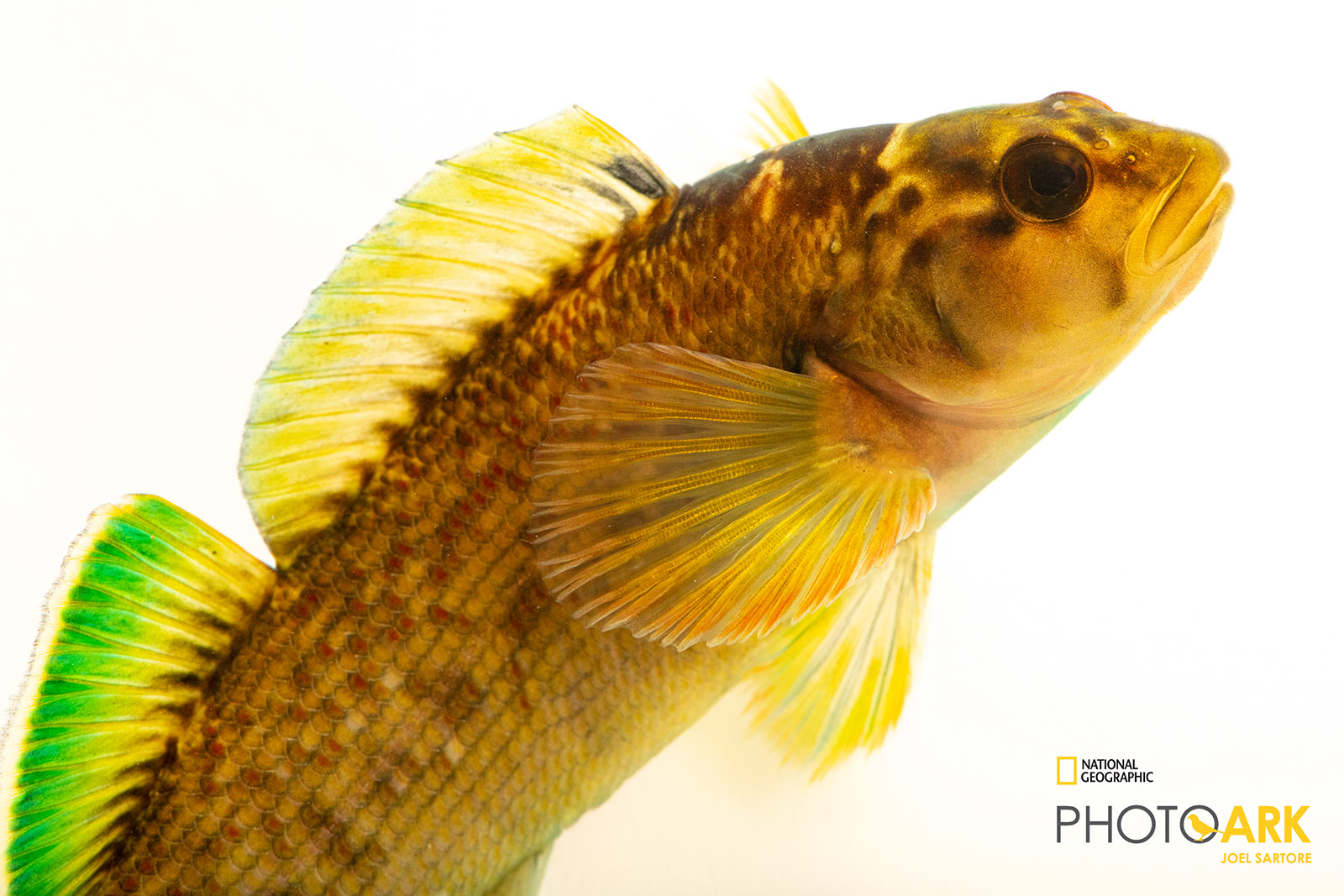
The greenfin darters, one of the more than 40 darter species in Virginia’s waters. Photo by Joel Sartore/National Geographic Photo Ark
Darters are an all-North American group that belong to the larger fish family of Percidae, whose members are found throughout the northern hemisphere and include notable game species such as walleye, sauger, and yellow perch. All but one of the approximately 248 darter species occurs east of the continental divide. Virginia has 46 species that comprise 20 percent of its total freshwater fish fauna. In size, they range from the one-inch golden darter (Nothonotus denoncourti) to the seven-inch Roanoke logperch (Percina rex).
To observe darters at their most stunning requires timing your visit with their breeding season, which for most species is between late winter and early summer. Comparable to birds, it’s the males that are the more colorful gender while females are drabber and more subdued. Similar to their avian counterparts, the male’s adornment has the primary purpose to impress the opposite sex. In full display, rival males conduct ritual, but non-lethal, combat of fin nipping, shoving, and chasing. The female, in the meantime, patiently waits to determine the winner of her affection.
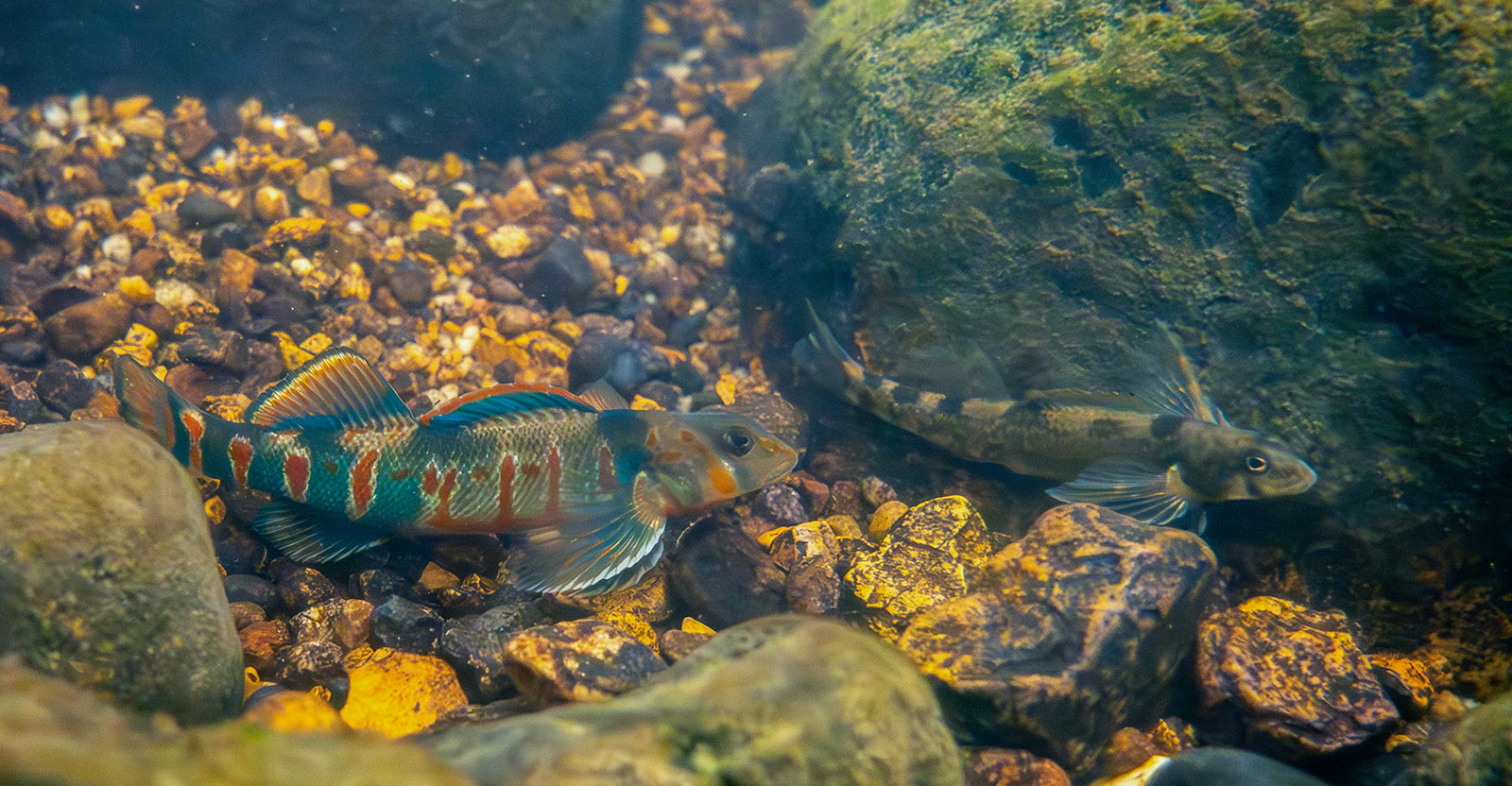
A male candy darter (left) in full breeding color, and a drabber-colored female candy darter (right). Photo by Maddie Cogar/DWR
Life in Fast Water
Darters live life in the fast lane. In streams and rivers, these habitats are riffles and rapids where water velocities are high and depths are shallow. Here, some fish are always at risk of being swept away or spending valuable energy just to maintain position. Darters, in contrast, are specially adapted to live in this dynamic and shifting habitat. In addition to being small, darters are cylindrical and streamlined, both of which allow them to reduce drag. Another adaptation is that their pectoral fins are disproportionally large, so the water’s flow over the fins allows the fish to effortlessly stay stationary on the stream bottom even in the fastest currents.
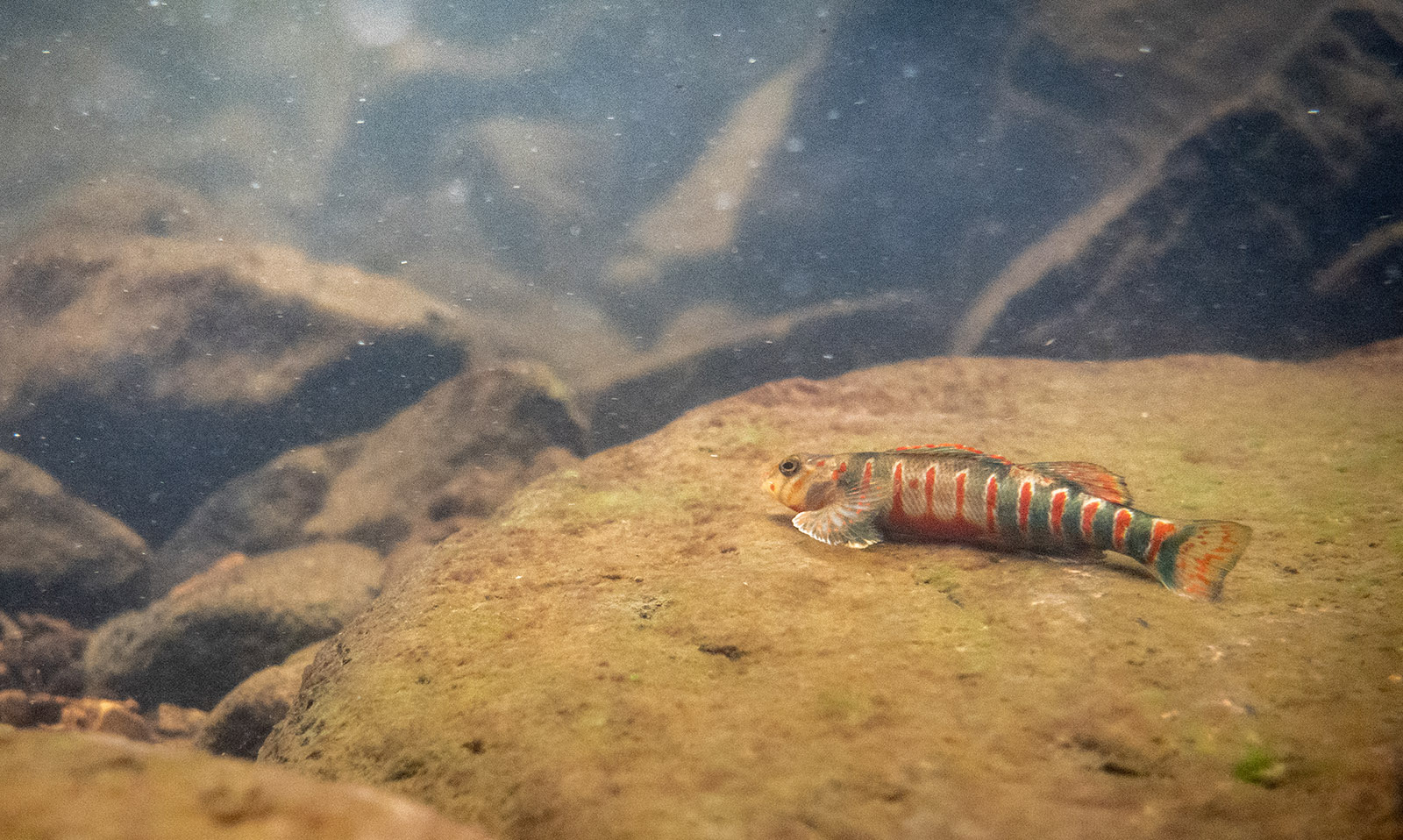
Darters such as the candy darter can stay stationary in fast water thanks to their large pectoral fins and body shape. Photo by Maddie Cogar/DWR
Internally, it’s not what they have but what they’re missing. The swim bladder is an organ evolved in fish that allows them to regulate position vertically in the water column. Depending on the darter species, the swim bladder has either become very small or is missing entirely. So interconnected are they to the stream bottom, darters cannot swim like most fish but—as the name states—move about by “darting” from one place to another.
Despite darters being well suited to live in such a hostile and turbulent environment, it is a wonder why anything would want to call it home. The answer comes down to one word, “food”—either eating it or being it. Darters have small mouths and correspondingly eat small meals. The smallest food items where they live are aquatic invertebrates, especially the larva of midges, mayflies, stoneflies, and caddisflies, which are found in abundance where dissolved oxygen levels are the highest. These areas are by no coincidence the same ones inhabited by darters that search for insect prey in between and on the underside of cobble and gravel.
While residing at an all-you-can-eat buffet seems pretty awesome, it is also beneficial because it’s the same place where many other fish, mainly the big hungry ones, prefer not to be. If a darter is caught in the open, a bass or trout could readily invite it for dinner. Brightly colored males, particularly those distracted during the breeding season, can be highly susceptible to this invitation. Predatory fish do occasionally visit the darter’s fast flowing realm, but they can only stay for short periods before having to return to rest in calmer waters. When a predator is present, darters are very wary and will quickly hid under rocks and other cover until the threat passes.
By observing darters, you’ll soon find out that they are not just another pretty face, but also have interesting behaviors and personalities. Nowhere is this emphasized more than in a group known as logperch. Logperch are more accessorized than your typical darter design with the addition of a long, fleshy snout. Whereas other fishes go about picking bugs off rocks or waiting for food to float to them, logperch take a more active approach by using their snout to flip stones and sticks. Once they’ve turned something over, they quickly inspect and gobble up any edible prey. So hardwired is this behavior that a logperch only a few weeks old will use its snout to turn over tiny sand grains.
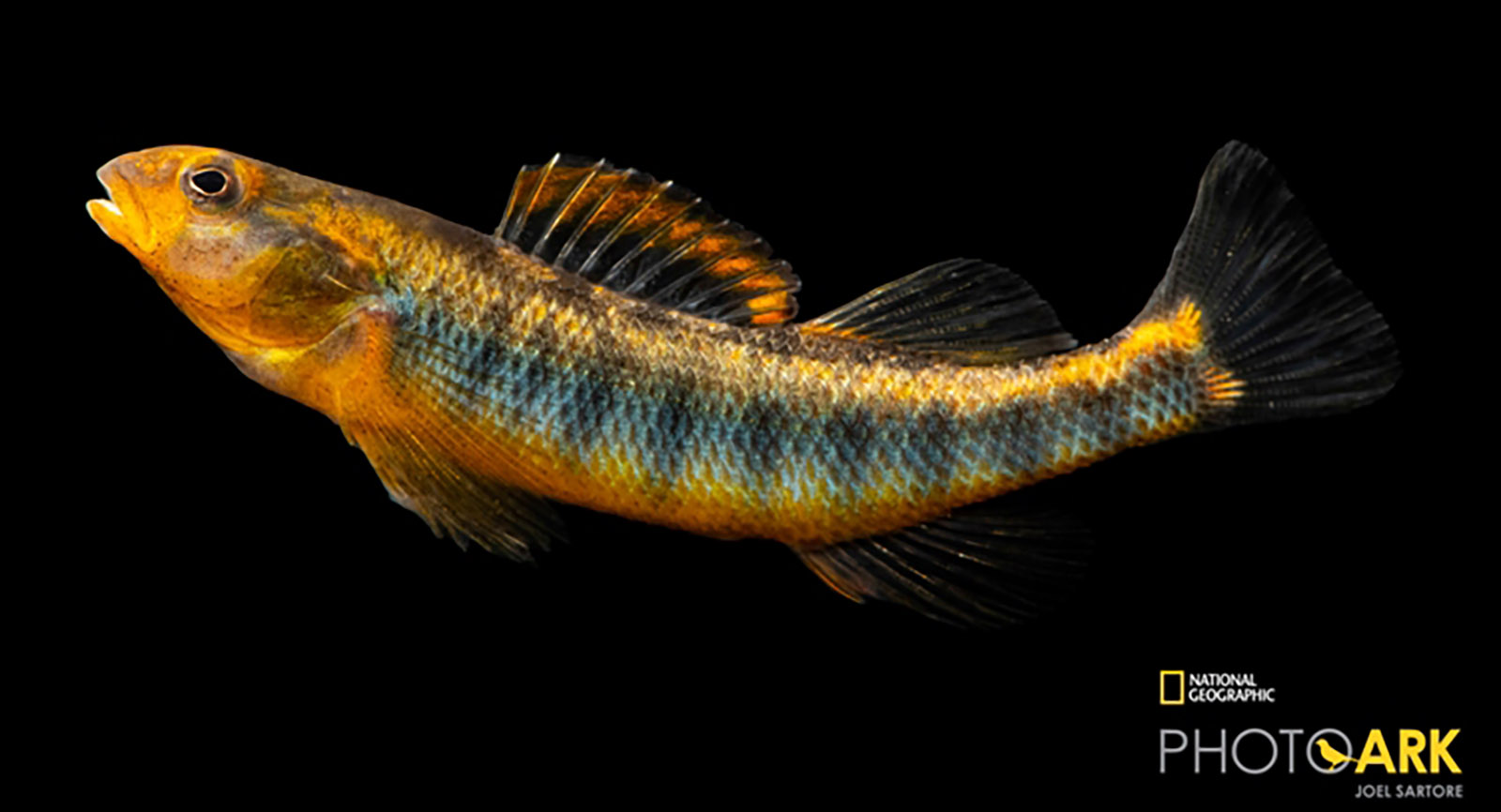
A Roanoke darter. Photo by Joel Sartore/National Geographic Photo Ark
See For Yourself
If you’ve decided to view darters in the wild, it is best to find a stream or river with good water quality. This is because darters prefer clean, clear water with minimal pollution. Biologists consider them indicators of good water quality. When large numbers of multiple species are present, it is one sign of a healthy aquatic environment. Poor water quality, mostly in the form of sedimentation, is the main reason darters are the most endangered fish group in North America.
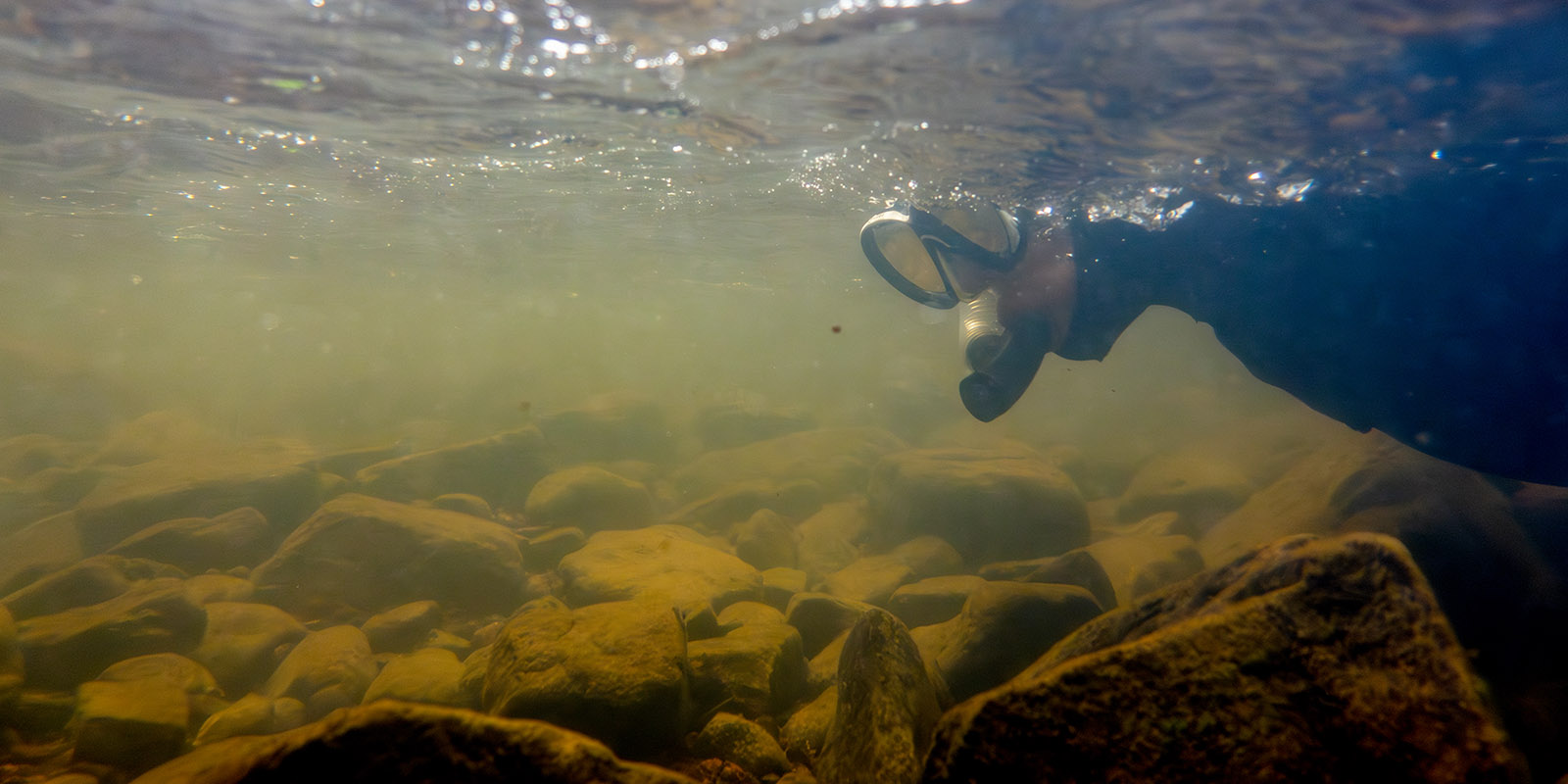
Snorkeling in streams is the best way to spot a darter. Photo by Maddie Cogar/DWR
Sediment primarily comes from disturbed and eroded soils being washed into a stream where it inevitably settles on the bottom, smothering suitable habitat. We can all do our part to improve water quality by replanting disturbed areas, restoring streambanks, planting trees along waterways, and conducting best management practices where ever possible.
Although there are several techniques to observe darters, one of the most effective is by snorkeling. (You can read more about river snorkeling in the May/June 2021 issue of Virginia Wildlife.) A dive mask and snorkel can be purchased at your local sporting or scuba diving store. Because darter habitat is typically shallow, you will not need flippers like those used to swim in open water. Instead, a pair of kneepads and wading shoes will be necessary to prevent scraping your knees and feet on loose, slippery rocks. In cold water, a wet suit—whether bought, rented, or borrowed—will keep your focus on your target and less on the loss of feeling in your extremities. Be mindful of where you place your hands and feet in case of broken glass or other dangerous objects.
Find a place in the river where you can securely and safely position yourself facing upstream in fast current. As you initially move into an area, darters are usually skittish but soon return to behaving naturally. In fact, darters can be quite inquisitive, so you may discover them coming over to check you out. An underwater camera is a great idea since this is the time for taking pictures and video. Once comfortably back home, these pictures will also come in handy to identify your observations. There are several good references including Peterson Field Guide to Freshwater Fishes of North America and Field Guide to Freshwater Fishes of Virginia that provide information on the identification, biology, and distribution of darters and other fish species you may encounter.
After taking the plunge, you’ll quickly realize that it doesn’t take a trip to a coral reef to experience amazing animals. Our own rivers and streams contain brilliantly colorful darters in addition to a multitude of other fascinating aquatic creatures just waiting to be discovered. As your curiosity expands, the more you’ll come to appreciate that what sustains them—rivers running clean and clear—is the same that sustain us all. Emboldened with this knowledge, you’ll soon understand that we all have a responsibility to protect this precious and vital resource.
Michael Pinder is a DWR aquatic biologist specializing in the conservation of endangered fishes and co-author of Field Guide to Freshwater Fishes of Virginia. This article appeared in the March/April 2022 issue of Virginia Wildlife magazine.

This article originally appeared in Virginia Wildlife Magazine.
For more information-packed articles and award-winning images, subscribe today!
Learn More & Subscribe




